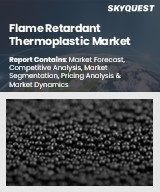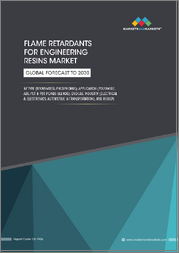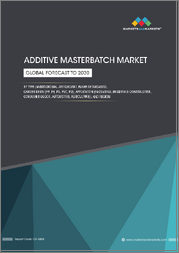
|
시장보고서
상품코드
1677799
난연성 화학제품 시장 규모, 점유율, 성장 분석 : 제품 유형별, 최종사용자 산업별, 용도별, 지역별 - 산업 예측(2025-2032년)Flame Retardant Chemicals Market Size, Share, and Growth Analysis, By Product Type, By End-User Industry, By Application, By Region - Industry Forecast 2025-2032 |
||||||
난연성 화학제품 시장 규모는 2023년에 80억 6,000만 달러로, 2024년 85억 3,000만 달러에서 2032년에는 133억 9,000만 달러로 확대하며, 예측 기간(2025-2032년)의 CAGR은 5.8%로 성장할 전망입니다.
난연제 수요가 증가하는 배경에는 엄격한 화재 안전 규제에 대응하여 전기-전자, 운송, 건설 등 다양한 산업에서 난연제 채택이 확대되고 있기 때문입니다. 기업이 안전 기준을 준수하기 위해 난연재를 채택하는 경향이 강화되면서 가연성 제품에서 화재 안전의 중요성에 대한 소비자의 인식도 높아지고 있습니다. 이러한 인식은 가정과 직장의 다양한 가전제품과 소비재에서 화재 위험에 대한 보호 강화의 필요성을 강조하고 있습니다. 그 결과, 난연제에 대한 수요가 크게 증가하여 다양한 분야에서 안전과 규정 준수를 보장하기 위한 다양한 노력을 반영하고 있습니다.
목차
서론
- 조사의 목적
- 조사 범위
- 정의
조사 방법
- 정보 조달
- 2차와 1차 데이터 방법
- 시장 규모 예측
- 시장의 전제조건과 제한
개요
- 세계 시장 전망
- 공급과 수요 동향 분석
- 부문별 기회 분석
시장 역학과 전망
- 시장 개요
- 시장 규모
- 시장 역학
- 촉진요인과 기회
- 억제요인과 과제
- Porter의 산업 분석
주요 시장 인사이트
- 주요 성공 요인
- 경쟁의 정도
- 주요 투자 기회
- 시장 에코시스템
- 시장의 매력 지수(2024년)
- PESTEL 분석
- 거시경제 지표
- 밸류체인 분석
- 가격 분석
난연성 화학제품 시장 규모 : 제품 유형별 & CAGR(2025-2032)
- 시장 개요
- 비할로겐화 난연제
- 할로겐계 난연제
- ATH(Aluminum trihydrate)
- 산화 안티몬
- 브롬화
- 염소화
- 인
- 질소
- 기타
난연성 화학제품 시장 규모 : 최종사용자 산업별 & CAGR(2025-2032)
- 시장 개요
- 전기·전자
- 건물·건설
- 와이어·케이블
- 섬유
- 운송기관
- 섬유·가구
난연성 화학제품 시장 규모 : 용도별 & CAGR(2025-2032)
- 시장 개요
- 에폭시
- 폴리올레핀
- 불포화 폴리에스테르
- 폴리염화비닐
- 폴리우레탄
- ABS와 블렌드
- 폴리스티렌
- 기타
난연성 화학제품 시장 규모 : 지역별 & CAGR(2025-2032)
- 북미
- 미국
- 캐나다
- 유럽
- 독일
- 스페인
- 프랑스
- 영국
- 이탈리아
- 기타 유럽 지역
- 아시아태평양
- 중국
- 인도
- 일본
- 한국
- 기타 아시아태평양
- 라틴아메리카
- 브라질
- 기타 라틴아메리카 지역
- 중동 및 아프리카
- GCC 국가
- 남아프리카공화국
- 기타 중동 및 아프리카
경쟁 정보
- 상위 5사의 비교
- 주요 기업의 시장 포지셔닝(2024년)
- 주요 시장 기업이 채택한 전략
- 최근 시장 동향
- 기업의 시장 점유율 분석(2024년)
- 주요 기업의 기업 개요
- 기업의 상세
- 제품 포트폴리오 분석
- 기업의 부문별 점유율 분석
- 매출의 전년대비 비교(2022-2024)
주요 기업 개요
- Albemarle Corporation(United States)
- Apexical Inc.(United States)
- BASF SE(Germany)
- Clariant(Switzerland)
- DAIHACHI CHEMICAL INDUSTRY CO. LTD(Japan)
- DIC CORPORATION(Japan)
- Dow(United States)
- Eti Maden(Turkey)
- ICL Group(Israel)
- J.M. Huber Corporation(United States)
- Jiangsu Jacques Technology Co. Ltd(China)
- Kemipex(United Arab Emirates)
- LANXESS(Germany)
- MPI Chemie BV(Netherlands)
- Nabaltec AG(Germany)
- Nyacol Nano Technologies Inc.(United States)
- RIN KAGAKU KOGYO Co. Ltd(Japan)
- RTP Company(United States)
- Sanwa Chemical Co. Ltd(Japan)
결론과 제안
KSA 25.04.17Flame Retardant Chemicals Market size was valued at USD 8.06 billion in 2023 and is poised to grow from USD 8.53 billion in 2024 to USD 13.39 billion by 2032, growing at a CAGR of 5.8% during the forecast period (2025-2032).
The rising demand for flame retardants is driven by their growing adoption across various industries, such as electrical and electronics, transportation, and construction, in response to stringent fire safety regulations. As organizations increasingly integrate fire-resistant materials to comply with safety standards, consumer awareness regarding the importance of fire safety in combustible products is also on the rise. This awareness underscores the necessity for enhanced protection against fire hazards in an array of electrical appliances and consumer goods within homes and workplaces. Consequently, the demand for flame retardants is set to expand significantly, reflecting a broader commitment to ensuring safety and compliance across multiple sectors.
Top-down and bottom-up approaches were used to estimate and validate the size of the Flame Retardant Chemicals market and to estimate the size of various other dependent submarkets. The research methodology used to estimate the market size includes the following details: The key players in the market were identified through secondary research, and their market shares in the respective regions were determined through primary and secondary research. This entire procedure includes the study of the annual and financial reports of the top market players and extensive interviews for key insights from industry leaders such as CEOs, VPs, directors, and marketing executives. All percentage shares split, and breakdowns were determined using secondary sources and verified through Primary sources. All possible parameters that affect the markets covered in this research study have been accounted for, viewed in extensive detail, verified through primary research, and analyzed to get the final quantitative and qualitative data.
Flame Retardant Chemicals Market Segments Analysis
Global Flame Retardant Chemicals Market is segmented by Product Type, End-User Industry, Application and region. Based on Product Type, the market is segmented into Non-halogenated Flame Retardant Chemicals, Halogenated Flame Retardants Chemicals, Aluminum trihydrate (ATH), Antimony Oxide, Brominated, Chlorinated, Phosphorus, Nitrogen and Others. Based on End-User Industry, the market is segmented into Electrical and Electronics, Buildings and Construction, Wires And Cables, Texitles, Transportation and Textile and Furniture. Based on Application, the market is segmented into Epoxy, Polyolefins, Unsaturated polyesters, Polyvinyl chloride, Polyurethane, ABS & blends, Polystyrene and Others. Based on region, the market is segmented into North America, Europe, Asia Pacific, Latin America and Middle East & Africa.
Driver of the Flame Retardant Chemicals Market
The flame retardant chemicals market is experiencing significant growth driven by heightened fire safety awareness across various sectors such as construction, electronics, automotive, and textiles. These chemicals play a critical role in reducing fire risks by preventing or delaying the ignition of materials. The rising frequency of fire incidents globally has intensified the need for these solutions, prompting consumers, businesses, and government bodies to acknowledge the importance of fire safety measures. Governments are implementing stricter regulations, particularly in the construction sector, to comply with fire safety standards, such as NFPA 703. Consequently, increased utilization of flame retardant chemicals to enhance the safety of buildings, vehicles, and electronic devices is expected in the coming years.
Restraints in the Flame Retardant Chemicals Market
The Flame Retardant Chemicals market is facing significant challenges due to growing concerns regarding the health risks posed by certain flame retardant compounds, particularly polybrominated diphenyl ethers (PBDEs). These chemicals have been associated with various serious health issues, including developmental disorders, hormonal disruptions, and an increased risk of cancer. Notably, in June 2006, both the California legislature and the European Union enacted bans on two key commercial grades of PBDEs in response to these concerns. Such regulatory actions and public apprehension about the safety of these substances may hinder market growth and innovation in safer alternatives.
Market Trends of the Flame Retardant Chemicals Market
The Flame Retardant Chemicals market is witnessing a significant upward trend, primarily fueled by the escalating emphasis on fire safety regulations and building codes across various sectors, particularly construction. This surge in demand for enhanced fire protection measures is driving the adoption of flame retardant chemicals in insulation materials, textiles, and coatings, ensuring enhanced safety standards. Additionally, growing public awareness of fire hazards and environmental concerns surrounding fire safety are prompting manufacturers to develop more effective and eco-friendly flame retardant formulations. As a result, the market is poised for robust growth, supported by innovation and regulatory compliance, shaping a safer built environment.
Table of Contents
Introduction
- Objectives of the Study
- Scope of the Report
- Definitions
Research Methodology
- Information Procurement
- Secondary & Primary Data Methods
- Market Size Estimation
- Market Assumptions & Limitations
Executive Summary
- Global Market Outlook
- Supply & Demand Trend Analysis
- Segmental Opportunity Analysis
Market Dynamics & Outlook
- Market Overview
- Market Size
- Market Dynamics
- Drivers & Opportunities
- Restraints & Challenges
- Porters Analysis
- Competitive rivalry
- Threat of substitute
- Bargaining power of buyers
- Threat of new entrants
- Bargaining power of suppliers
Key Market Insights
- Key Success Factors
- Degree of Competition
- Top Investment Pockets
- Market Ecosystem
- Market Attractiveness Index, 2024
- PESTEL Analysis
- Macro-Economic Indicators
- Value Chain Analysis
- Pricing Analysis
Global Flame Retardant Chemicals Market Size by Product Type & CAGR (2025-2032)
- Market Overview
- Non-halogenated Flame Retardant Chemicals
- Halogenated Flame Retardants Chemicals
- Aluminum trihydrate (ATH)
- Antimony Oxide
- Brominated
- Chlorinated
- Phosphorus
- Nitrogen
- Others
Global Flame Retardant Chemicals Market Size by End-User Industry & CAGR (2025-2032)
- Market Overview
- Electrical and Electronics
- Buildings and Construction
- Wires And Cables
- Texitles
- Transportation
- Textile and Furniture
Global Flame Retardant Chemicals Market Size by Application & CAGR (2025-2032)
- Market Overview
- Epoxy
- Polyolefins
- Unsaturated polyesters
- Polyvinyl chloride
- Polyurethane
- ABS & blends
- Polystyrene
- Others
Global Flame Retardant Chemicals Market Size & CAGR (2025-2032)
- North America (Product Type, End-User Industry, Application)
- US
- Canada
- Europe (Product Type, End-User Industry, Application)
- Germany
- Spain
- France
- UK
- Italy
- Rest of Europe
- Asia Pacific (Product Type, End-User Industry, Application)
- China
- India
- Japan
- South Korea
- Rest of Asia-Pacific
- Latin America (Product Type, End-User Industry, Application)
- Brazil
- Rest of Latin America
- Middle East & Africa (Product Type, End-User Industry, Application)
- GCC Countries
- South Africa
- Rest of Middle East & Africa
Competitive Intelligence
- Top 5 Player Comparison
- Market Positioning of Key Players, 2024
- Strategies Adopted by Key Market Players
- Recent Developments in the Market
- Company Market Share Analysis, 2024
- Company Profiles of All Key Players
- Company Details
- Product Portfolio Analysis
- Company's Segmental Share Analysis
- Revenue Y-O-Y Comparison (2022-2024)
Key Company Profiles
- Albemarle Corporation (United States)
- Company Overview
- Business Segment Overview
- Financial Updates
- Key Developments
- Apexical Inc. (United States)
- Company Overview
- Business Segment Overview
- Financial Updates
- Key Developments
- BASF SE (Germany)
- Company Overview
- Business Segment Overview
- Financial Updates
- Key Developments
- Clariant (Switzerland)
- Company Overview
- Business Segment Overview
- Financial Updates
- Key Developments
- DAIHACHI CHEMICAL INDUSTRY CO. LTD (Japan)
- Company Overview
- Business Segment Overview
- Financial Updates
- Key Developments
- DIC CORPORATION (Japan)
- Company Overview
- Business Segment Overview
- Financial Updates
- Key Developments
- Dow (United States)
- Company Overview
- Business Segment Overview
- Financial Updates
- Key Developments
- Eti Maden (Turkey)
- Company Overview
- Business Segment Overview
- Financial Updates
- Key Developments
- ICL Group (Israel)
- Company Overview
- Business Segment Overview
- Financial Updates
- Key Developments
- J.M. Huber Corporation (United States)
- Company Overview
- Business Segment Overview
- Financial Updates
- Key Developments
- Jiangsu Jacques Technology Co. Ltd (China)
- Company Overview
- Business Segment Overview
- Financial Updates
- Key Developments
- Kemipex (United Arab Emirates)
- Company Overview
- Business Segment Overview
- Financial Updates
- Key Developments
- LANXESS (Germany)
- Company Overview
- Business Segment Overview
- Financial Updates
- Key Developments
- MPI Chemie BV (Netherlands)
- Company Overview
- Business Segment Overview
- Financial Updates
- Key Developments
- Nabaltec AG (Germany)
- Company Overview
- Business Segment Overview
- Financial Updates
- Key Developments
- Nyacol Nano Technologies Inc. (United States)
- Company Overview
- Business Segment Overview
- Financial Updates
- Key Developments
- RIN KAGAKU KOGYO Co. Ltd (Japan)
- Company Overview
- Business Segment Overview
- Financial Updates
- Key Developments
- RTP Company (United States)
- Company Overview
- Business Segment Overview
- Financial Updates
- Key Developments
- Sanwa Chemical Co. Ltd (Japan)
- Company Overview
- Business Segment Overview
- Financial Updates
- Key Developments



















